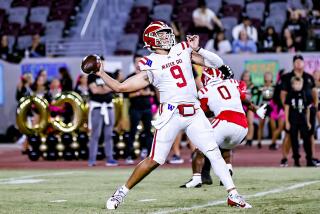School Sports: Not Just Playing Games
The lineup includes recently retired NFL running back Aaron Craver, three college coaches, a prominent Los Angeles high school coach and an Olympic gold medalist.
The goal: instant athletic credibility for a private Orange County high school that hasn’t even opened. Their arrival at the Roman Catholic school underscores the importance of teenage sports in affluent South County, and of aggressive self-promotion in the increasingly competitive world of high school athletics.
For the record:
12:00 a.m. Aug. 16, 2003 For The Record
Los Angeles Times Saturday August 16, 2003 Home Edition Main News Part A Page 2 National Desk 1 inches; 52 words Type of Material: Correction
Junipero Serra High School -- An article in the California section Sunday about Junipero Serra High School’s athletic program incorrectly reported that development of the school’s athletic fields has been approved by San Juan Capistrano. Although the city has agreed to a zoning change, other approvals are needed before construction can begin.
Coaches from other campuses are watching as the new Junipero Serra High School in San Juan Capistrano markets itself like a movie studio trying to generate hype before a premiere.
By publicizing its athletic staff the way other schools tout test scores, Junipero Serra wants to catapult into the kind of sports prominence that might otherwise take years to achieve.
“We want to be a powerhouse,” said school founder and president Tim Busch. “Right or wrong, in today’s society a great athletic program brings fame to a school.”
The proposed campus facilities add to the buzz surrounding Junipero Serra’s athletic program. Cameras will beam videos of practices and games directly to students’ computers. Fields will sport the type of turf the National Football League uses, the 50-meter pool will be certified for Olympic events and the 60,000-square-foot gym will hold 2,000 spectators.
“They’re shooting for the moon, and good luck to them,” said Bob Johnson, Mission Viejo High School’s football coach, who has won back-to-back regional titles.
In the five years since plans for Junipero Serra were unveiled, boosters have chosen their site and won city approval, and continue to defend against an ongoing lawsuit by the Juaneno Indians over constructing athletic fields on ancient burial grounds.
The school’s founders, a group of philanthropists and business people, have raised $40 million for the school and $22 million for the athletic facilities, and are focusing on raising $8 million for a performing-arts center. The classrooms are converted industrial park offices.
Classes begin next month, and construction of most of the athletic fields is scheduled to begin by 2004, said school architect and Trustee Daniel Conrardy. Teams will practice and play at local sites until their facilities open.
But the school will not build its own football stadium, because of space limitations. Instead, the team will play at Saddleback Community College.
It’s unclear what effect the opening of Junipero Serra, which hopes for an ultimate enrollment of 2,000 students, will have on nearby, 1,700-student Santa Margarita Catholic High School. Private schools have no attendance boundaries, and both schools, which each charge about $7,000 annual tuition, pull widely from South County.
Curt Bauer, a Santa Margarita soccer coach, said he worries there will not be enough students to sustain both campuses. “I’m afraid we’re going to have two half-full schools,” he said.
JSerra, as the school is nicknamed, was established to provide a stronger emphasis on prayer and religious instruction, said Busch. But schools, he added, most effectively promote themselves through athletics, and others agree.
“Unfortunately, what gets the headlines is your athletic program,” said Bruce Rollinson, who in 14 years as football coach at Mater Dei High School in Santa Ana has won five regional titles and a national reputation. “We’re tradition-rich in visual and performing arts. But if you’re going to try and promote yourselves, your best promotion is your athletic program.”
Busch said success won’t come overnight, and that coaches realized when they signed on that it could take seven years to build a competitive program.
“We didn’t want to wait around for the program to be built,” said Busch, CEO of an Irvine-based real estate law firm. “We need it now.”
Such emphasis on sports draws criticism. “Sports are not in high schools to create All-Americans,” said Robert Kanaby, director of the National Federation of State High School Assns., which writes the playing rules for high school sports. “It’s there to teach them educational experiences they’re not going to get anywhere else. The idea is not to make it in sports, but to make it in life.”
More to Read
Get our high school sports newsletter
Prep Rally is devoted to the SoCal high school sports experience, bringing you scores, stories and a behind-the-scenes look at what makes prep sports so popular.
You may occasionally receive promotional content from the Los Angeles Times.






